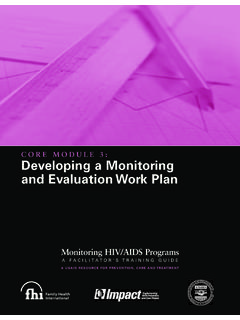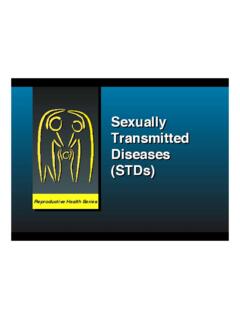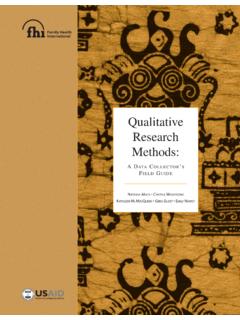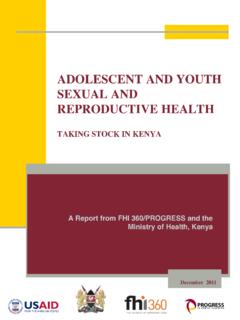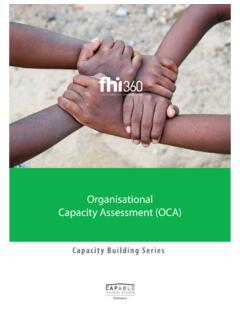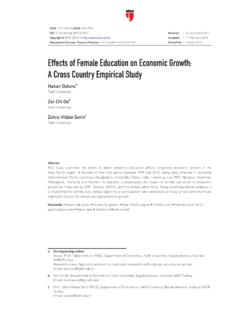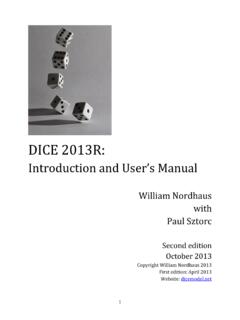Transcription of Vulnerability Assessment Methodologies: A Review of the ...
1 Vulnerability Assessment Methodologies: A Review of the Literature Vulnerability Assessment Methodologies: A Review of the Literature March 2014. Whitney Moret ASPIRES. This report was produced under United States Agency for International development (USAID) Cooperative Agreement No. AID-OAA-LA-13- 00001. The contents are the responsibility of FHI 360 and do not necessarily reflect the views of USAID or the United States Government. 1. Contents 1. Introduction .. 4. Levels of Analysis .. 4. Method .. 4. 2. Theories of Vulnerability .. 4. Perspectives on Vulnerability By Discipline .. 5. Disaster Management, Ecology, and Hazards Perspectives .. 5. Anthropology/Sociology Perspectives .. 5. Economics Perspectives .. 5. Vulnerability in economic Strengthening .. 6. Vulnerability vs. Poverty .. 6. Vulnerability as Multiple Stressors .. 7. Vulnerability vs. 7. 3. Vulnerability Assessment Approaches .. 7. Principles of Vulnerability Assessment .
2 7. Comprehensive Livelihoods Frameworks: Macro to Micro Level Measures .. 8. Southern Africa Vulnerability Initiative (SAVI) Framework .. 9. Household Economy Approach (HEA) .. 10. Household Livelihood Security Analysis (HLSA) .. 13. Population Level Measures .. 16. Poverty Measures: PPI and 16. Local Vulnerability Index (LVI).. 18. Household Vulnerability Index (HVI)).. 19. Econometric Measures: VEP, VEU, and VER .. 21. Participatory Vulnerability Analysis (PVA) and Participatory Vulnerability and Capacity Analysis (PVCA) .. 22. Individual and Household Measures and Targeting .. 23. Summary Table .. 25. 4. Adapting Approaches to Intervention Needs .. 30. Case Studies .. 30. IMARISHA .. 30. SCORE .. 31. Discussion .. 33. 5. Conclusion .. 34. 2. Sources .. 35. Apendix I. Household Livelihood Security Analysis .. 40. Factor Analysis Output Example from CARE Zimbabwe .. 40. Targeting Guide Example from CARE Zimbabwe .. 41. HLSA Questionnaire.
3 43. Appendix II. Household Vulnerability Index Technical Information .. 54. Theoretic Framework .. 54. HVI Equation .. 55. The Three HVI Categories .. 57. HVI input 58. Livestock 62. Appendix III. Local Vulnerability Index (LVI) Variables and Outputs .. 64. Appendix IV. Examples of VEP Data Outputs .. 66. Appendix V. PAT Survey Example .. 73. Appendix VI. Example of PPI Scorecard .. 75. Appendix VII. Participatory Vulnerability Assessment Summary .. 76. Appendix VIII. Participatory Vulnerability and Capability Analysis .. 78. Appendix IX. Participatory Wealth Ranking Forms .. 80. Appendix X: SCORE Vulnerability Assessment Tool .. 88. 3. 1. INTRODUCTION. Vulnerability is an elusive concept. Its definition varies across disciplines, ranging from engineering to psychology to economics. In the development community, Vulnerability has become an important concept used to guide the design, evaluation, and targeting of programs. In southern Africa, for instance, governments, NGOs, UN agencies, and other groups formed country-level Vulnerability Assessment Committees starting in 1999 to harmonize and improve methods of assessing Vulnerability , with a focus on food aid (Frankenberger, Mock, & Jere, 2005).
4 Since then, practitioners have given greater emphasis to the multidimensionality of Vulnerability , working with a variety of measures to capture the complexity of the concept. For the purposes of this Review , we use the broad and established definition of Vulnerability in sustainability science as the degree to which a system, subsystem, or system component is likely to experience harm due to exposure to a hazard, either a perturbation or stress/stressor (Turner et al., 2003, p. 74). This literature Review provides an overview of the tools and methods used to measure Vulnerability , as pertains to development interventions focused on economic strengthening, at the population level as well as the household and individual level. Levels of Analysis Vulnerability Assessment methodology is determined by the overarching conceptual framework chosen, including a definition of Vulnerability that specifies risks for measurement. It also depends on the intended use of the Assessment results, which may range from an intention to inform international policy or to spur community-level action.
5 As such, this Review distinguishes between methods focused at the population level and those at the household or individual level. This distinction is key, as methods applicable at one level may not be appropriate at another. At the population level, this Review includes approaches that can be considered macro and meso level methods. Macro level interventions typically include measures at the country level, with international and regional policy applications. Meso level measures include subnational measures, usually comprising quantitative measures based on census data or statistical sampling. At the individual and household, or micro level, however, Vulnerability is more frequently assessed using participative and qualitative measures for the purpose of program targeting. Though each level possesses unique requirements for analysis, they intersect in important ways, and the literature consistently recommends use of mixed methods. Method The scope of this Review is limited to methodologies relevant to interventions that fall under a broad definition of economic strengthening, including interventions that mitigate economic Vulnerability and enhance beneficiaries' ability to cope with shocks (Wolfe, 2011).
6 Sources include seminal pieces of published literature and their references, gray literature found on development program websites, and interviews with practitioners. 2. THEORIES OF Vulnerability . Given the diversity of uses and definitions applied to the concept of Vulnerability , it is useful to trace its 4. epistemological origins by discipline. Alwang, Siegel and J rgensen (2001) identify the following strands of literature on the topic: disaster management; environmental; economics, including poverty dynamics, asset- based approaches, sustainable livelihoods, and food security; anthropology/sociology; and health/nutrition. The theories that align most with Vulnerability as conceptualized for the purposes of economic strengthening interventions include frameworks that originate in the economics and anthropology/sociology literature. We also discuss disaster management literature, which has had a profound influence on the literature in general and comprises an important component in Vulnerability assessments performed by development and relief agencies.
7 We exclude the environmental literature, as its focus on environmental rather than social impact is not compatible with the aims of this Review . We also exclude the literature on health and nutrition because their focus is too narrow for our purposes. Perspectives on Vulnerability By Discipline Disaster Management, Ecology, and Hazards Perspectives A strong element in the literature on Vulnerability Assessment comes from the disaster management, ecology, and hazards literature, especially as related to climate change. The literature on hazards and Vulnerability from the 70s and 80s has had an important influence on the broader literature on Vulnerability (Prowse, 2003) and can be divided into two schools of thought: that under the behavioral paradigm, and that under the structuralist paradigm (Adger, 2006). The behavioral paradigm conceptualized hazards as resulting from overwhelming forces of nature and attributes a failure to cope with poor perception of hazards and risk.
8 (Burton et al., 1993 as cited in Adger, 2006). On the other hand, the structuralist paradigm conceived of the hazardous effects of natural disasters as attributable to the social and economic conditions that create Vulnerability . This latter approach has fostered a succeeding literature focused on greater cross-disciplinary integration and Assessment of Vulnerability based on multiple factors rather than a single stressor such as a natural disaster. The succeeding literature frequently incorporates the sustainable livelihoods/entitlement approaches introduced by economist Amartya Sen. Anthropology/Sociology Perspectives One distinctive feature of the anthropology and sociology literature is the conceptual distinction it creates between social Vulnerability and economic Vulnerability (Alwang et al., 2001). The concept of social Vulnerability has been incorporated into both the hazards and economic literature. Literature from this perspective focuses on the multidimensionality of poverty and encourages the use of participatory methods to understand the qualitative features of poverty, going beyond common economic methodologies of measuring proxies for poverty levels such as consumption.
9 This literature analyzes the roles of social institutions and power in creating Vulnerability . On the flip side, it also examines the ability to cope, or resilience, as connected to assets such as social capital. Alwang (2001) traces the origins of this asset-based perspective most strongly with the economics literature on Vulnerability , as discussed below. Economics Perspectives Alwang (2001) identifies three strands within the economics literature that conceptualize Vulnerability in terms of either poverty dynamics, food security, or sustainable livelihoods, specifying that the literature rarely separates risk response into its reduction, mitigating and coping components (p. 5). The poverty dynamics literature is concerned primarily with the risk of falling into poverty or deeper into poverty. Some writers, such as Prowse (2003), emphasize the importance of measures that factor in risk rather than using 5. static poverty measures. One trope within the literature is a discussion of the external and internal sides of Vulnerability , external referring to risk, and internal referring to individual capacities for coping (Chambers 1989, Moser 1998, as cited in Alwang 2001).
10 This movement toward dynamic measures reflects an overall shift in the literature favoring what has come to be known as the Sustainable Livelihoods approach. Chambers and Conway's oft-cited definition is that a livelihood comprises the capabilities, assets (stores, resources, claims and access) and activities required for a means of living: a livelihood is sustainable which can cope with and recover from stress and shocks, maintain or enhance its capabilities and assets, and provide sustainable livelihood opportunities for the next generation;. and which contributes net benefits to their livelihoods at the local and global levels and in the short and long term" (1991:6). This literature draws on the work of economist Amartya Sen, whose conception of entitlements laid the ground-work for asset-based analysis focused on livelihoods (Alwang 2001). Assets include items such as labor, human capital, housing, household relations, and social capital (Moser 1998), and they contribute to resilience.

